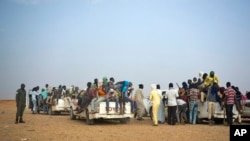The International Organization for Migration reports it has succeeded in rescuing nearly 20,000 migrants from near death in the Sahara Desert over the past two-and-one half years when it began its life-saving operation.
The last big rescue mission occurred on June 15 in Niger. An International Organization for Migration team canvassing the scorching desert terrain found 406 migrants stranded under the searing sun without water or food.
IOM spokesman, Joel Millman says the group included men, women and children from 14 West African countries, mainly from Guinea-Conakry, Mali and Ivory Coast. He says they were bound for North Africa, a stepping stone to Europe and a hoped -for better life.
“Trucks carrying migrants north frequently break-down in the desert; in other cases, they become lost or the smugglers simply abandon people to their fates," Millman said. "To this day, no one knows how many migrants have died attempting to cross the Sahara.”
Millman tells VOA the thousands of lives IOM has succeeded in saving are only a drop in the ocean.
“We know that probably thousands of victims are not even — their remains are not even evident anymore because they are covered by sand or consumed by animals," Millman said. "We can only rely on luck. I would say mostly in the ability to get resources marshalled. Sometimes local authorities can be very helpful. Sometimes resources are really stretched.”
Rescued migrants are taken to one of several IOM transit centers where they receive emergency humanitarian assistance. Millman says 98 percent of the migrants accept IOM’s offer to help them return to their homes. Despite their brush with death, he says after a year or so many migrants frequently decide to, once again, embark on the dangerous Sahara Desert crossing toward North Africa.






